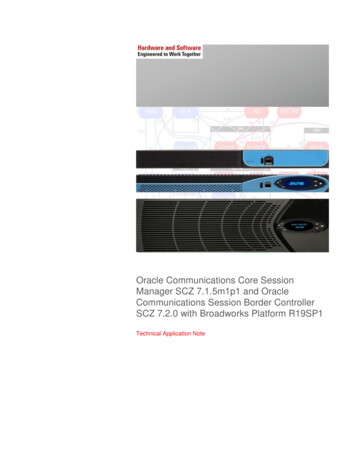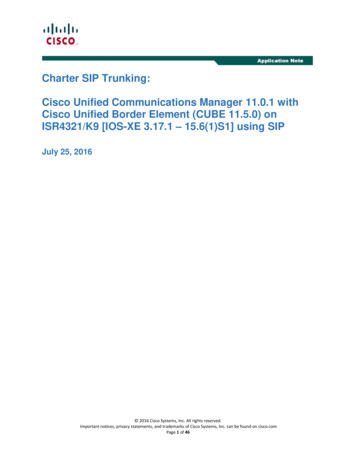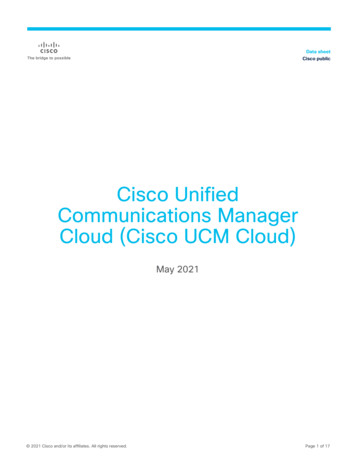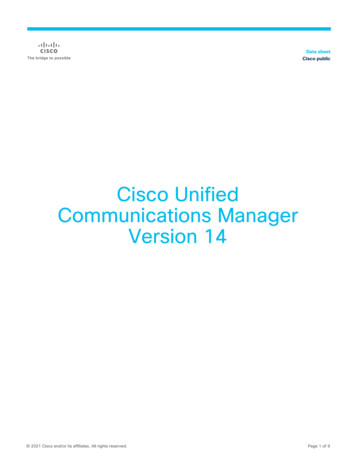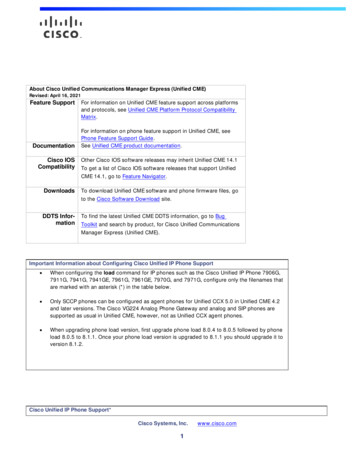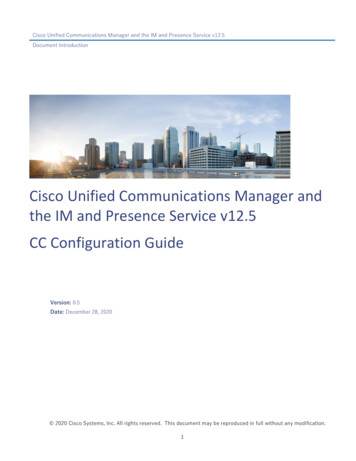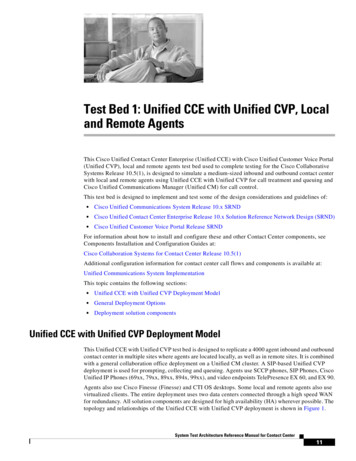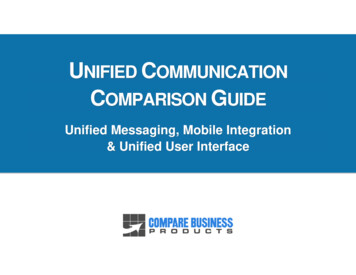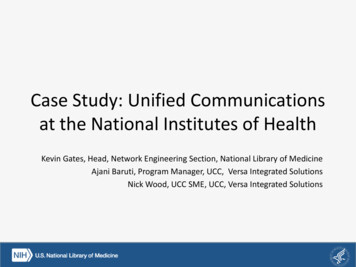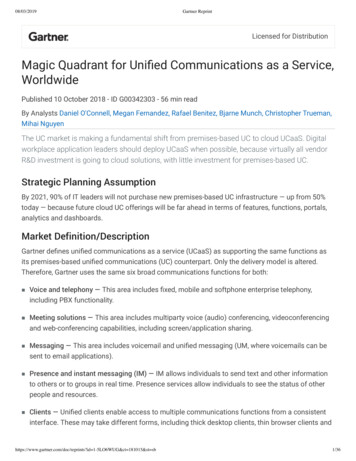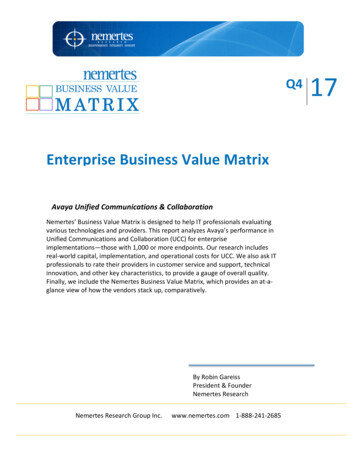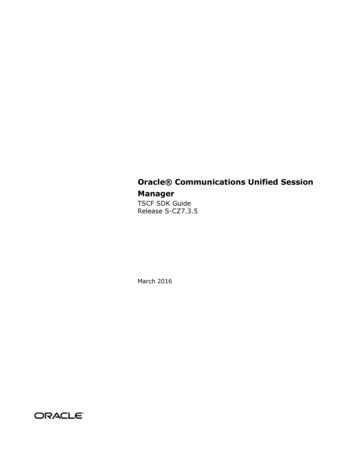
Transcription
Oracle Communications Unified SessionManagerTSCF SDK GuideRelease S-CZ7.3.5March 2016
NoticesCopyright 2016 Oracle and/or its affiliates. All rights reserved.This software and related documentation are provided under a license agreement containing restrictions on useand disclosure and are protected by intellectual property laws. Except as expressly permitted in your licenseagreement or allowed by law, you may not use, copy, reproduce, translate, broadcast, modify, license, transmit,distribute, exhibit, perform, publish, or display any part, in any form, or by any means. Reverse engineering,disassembly, or decompilation of this software, unless required by law for interoperability, is prohibited.The information contained herein is subject to change without notice and is not warranted to be error-free. If youfind any errors, please report them to us in writing.If this is software or related documentation that is delivered to the U.S. Government or anyone licensing it onbehalf of the U.S. Government, then the following notice is applicable:U.S. GOVERNMENT END USERS: Oracle programs, including any operating system, integrated software, anyprograms installed on the hardware, and/or documentation, delivered to U.S. Government end users are"commercial computer software" pursuant to the applicable Federal Acquisition Regulation and agency-specificsupplemental regulations. As such, use, duplication, disclosure, modification, and adaptation of the programs,including any operating system, integrated software, any programs installed on the hardware, and/ordocumentation, shall be subject to license terms and license restrictions applicable to the programs. No otherrights are granted to the U.S. Government.This software or hardware is developed for general use in a variety of information management applications. It isnot developed or intended for use in any inherently dangerous applications, including applications that maycreate a risk of personal injury. If you use this software or hardware in dangerous applications, then you shall beresponsible to take all appropriate fail-safe, backup, redundancy, and other measures to ensure its safe use.Oracle Corporation and its affiliates disclaim any liability for any damages caused by use of this software orhardware in dangerous applications.Oracle and Java are registered trademarks of Oracle and/or its affiliates. Other names may be trademarks of theirrespective owners.Intel and Intel Xeon are trademarks or registered trademarks of Intel Corporation. All SPARC trademarks areused under license and are trademarks or registered trademarks of SPARC International, Inc. AMD, Opteron, theAMD logo, and the AMD Opteron logo are trademarks or registered trademarks of Advanced Micro Devices.UNIX is a registered trademark of The Open Group.This software or hardware and documentation may provide access to or information about content, products, andservices from third parties. Oracle Corporation and its affiliates are not responsible for and expressly disclaim allwarranties of any kind with respect to third-party content, products, and services unless otherwise set forth in anapplicable agreement between you and Oracle. Oracle Corporation and its affiliates will not be responsible forany loss, costs, or damages incurred due to your access to or use of third-party content, products, or services,except as set forth in an applicable agreement between you and Oracle.
ContentsPreface: About This Guide. v1 Overview. 7TSM Tunnel. 8SDK Host Operating System Relationship. 8Provided Functionality. 102 Compiling the TSM Library and Documentation.13SDK Directories. 13Generating the API Documentation. 143 Accessing and Using the TSM SDK APIs. 17Sample TSM SDK-based Applications.17Using The SDK To Create A TSM Tunnel.18Enabling Redundancy.20Error Codes.20Glossary. 21Oracle Communications Unified Session Manager3
4Oracle Communications Unified Session Manager
PrefaceAbout This GuideThe Oracle Communications Unified Session Manager Tunneled Session Controller Function SDK Guide describesthe client-side SDK (software development kit) that facilitates the creation of secure tunnels between a clientapplication and an Oracle Communications Tunneled Session Controller (TSC) server. A client is typically asoftphone application that utilizes the SDK software libraries and source code to create TLS tunnels to a TSC service,thus achieving secure real time communications and ubiquitous firewall traversal.This document specifically describes the SDK, functional libraries, and source code supplied with the SDK Version1.4.0.Related DocumentationThe following table describes the documentation set for this release.Document NameDocument DescriptionAcme Packet 4500 Hardware Installation GuideContains information about the components and installation ofthe Acme Packet 4500.Acme Packet 4600 Hardware Installation GuideContains information about the components and installation ofthe Acme Packet 4600.Acme Packet 6100 Hardware Installation GuideContains information about the components and installation ofthe Acme Packet 6100.Acme Packet 6300 Hardware Installation GuideContains information about the components and installation ofthe Acme Packet 6300.ACLI Configuration GuideContains information about the administration and softwareconfiguration of the Service Provider Oracle CommunicationsUnified Session Manager.Accounting GuideContains information about the Oracle Communications UnifiedSession Manager’s accounting support, including details aboutRADIUS and Diameter accounting.Administrative Security EssentialsContains information about the Oracle Communications UnifiedSession Manager’s support for its Administrative Securitylicense.HDR Resource GuideContains information about the Oracle Communications UnifiedSession Manager’s Historical Data Recording (HDR) feature.
Document NameDocument DescriptionThis guide includes HDR configuration and system-widestatistical information.Installation and Platform Preparation GuideContains information about upgrading system images and anypre-boot system provisioning.MIB Reference GuideContains information about Management Information Base(MIBs), Oracle Communication's enterprise MIBs, general trapinformation, including specific details about standard traps andenterprise traps, Simple Network Management Protocol (SNMP)GET query information (including standard and enterpriseSNMP GET query names, object identifier names and numbers,and descriptions), examples of scalar and table objects.Release NotesContains information about the current documentation setrelease, including new features and management changes.Security GuideContains information about security considerations and bestpractices from a network and application security perspective forthe Oracle Communications Unified Session Manager family ofproducts.Revision HistoryDateRevision DescriptionMarch 2016 Initial Release
1OverviewTunnel Session Management (TSM) is a new feature on the Session Border Controller. Tunnel Session Managementdramatically improves firewall traversal for real time communications for OTT VoIP applications and reduces thedependency on SIP/TLS and SRTP by encrypting access-side VoIP within standardized VPN tunnels. As calls orsessions traverse a TSM tunnel, the USM will route all SIP and RTP traffic from within the TSM tunnel to the core(or appropriate destination).Oracle Communications is working with other telecom providers and vendors to standardize TSM. Within the 3GPP,TSM is called a Tunneled Services Control Function (TSCF). Currently the 3GPP Technical Requirement draft is TR33.8de V0.1.3 (2012-05) as a standardized approach for overcoming non-IMS aware firewall issues with supportingcompanies including China Mobile, Ericsson, Huawei, Intel, RIM, Vodafone, and ZTE. Beyond the standard, weprovide exceptional tunnel performance & capacity within the Oracle Communications Unified Session Manager aswell as high availability, DDoS protection and our patented TSM Tunnel Redundancy to improve audio quality inlossy networks such as the Internet.Figure 1: Basic TSM SetupOracle Communications Unified Session Manager7
OverviewTSM consists of two parts: the TSM server (often referred to as a TSCF or Tunneled Services Control Function)the TSM clientThe TSM server resides and runs on the SBC and the TSM client runs within applications that reside on workstations,laptops, tablets and mobile devices (ex. Android, iPhone or iPad) and even network elements.To deploy TSM enabled-clients such as softphones, SIP-enabled iOS/Android applications or contact center agentapplications, customers and 3rd party ISVs will need to incorporate the open source TSM software libraries into theirapplications which will establish tunnels to the TSM server.TSM TunnelThe following diagram briefly explains the various IP addresses utilized during the TSM session. TSCF External IP—This IP address is visible to any endpoint on the Internet and is used to initiate the TSMsession between the TC and the TSCF. This may be configured under security tscf tscf-interface. See theTSCF Essentials Guide to configure the TSCF function on the server.TC Source IP—This IP address corresponds to the source address of the TC in its respective access network or itcould be the IP of the Proxy behind which it is located.Internal Tunnel IP—This IP address will be assigned to the TC (once TLS authentication is successful) from aconfigured pool of IP addresses on the TSCF. It will be used to facilitate communication with the core (P-CSCF).The address pool can be configured under security tscf tscf-address-pool.TC Application IP—This is the IP address associated with the respective application (SIP / RTP / other) at the TC.SDK Host Operating System RelationshipThe following illustrations depict the relationship between the SDK and the host operating system8Oracle Communications Unified Session Manager
OverviewSDK/Host OS Relationship (Simplified View)Oracle Communications Unified Session Manager9
OverviewSDK/Host OS Relationship (Detailed View)Provided FunctionalityThis SDK release supports the following platforms: LinuxOS XiOS 9.2Android 102.3.x (Gingerbread)3.2.x (Honey Comb)4.0.X (Ice Cream Sandwich)4.4 (KitKat)5.X (Lollipop)Oracle Communications Unified Session Manager
Overview 6.X (Marshmallow)Windows Win32This SDK release supports: Server Assigned Configuration modeTunnel Transport TLS DTLSIP version IPv4IPv6 Note: When used in Decoupled Mode, the TSC also supports mixing IPv4 and IPv6. For example, youcan use an IPv6 external address outside the tunnel and an IPv4 address inside the tunnel, or vice versa.Payload multiplexing within a tunnelEach SDK instance can support: Up to 3 concurrent voice calls Up to 10 MSRP chat sessions 1 MSRP file transfer sessionSecurity Traversing Gateway (STG)Oracle Communications Unified Session Manager11
2Compiling the TSM Library and DocumentationRead the documentation that corresponds to your application's target operating system.Operating SystemDescriptionLocationThis file provides information on /tsm/sdk/lib/android-ndk/how to compile the TSM SDKREADME.tscfor the Android OSThis file provides information on /tsm/sdk/lib/README.ioshow to compile the TSM SDKfor the iOSThis file provides information on /tsm/sdk/lib/READMEhow to compile the TSM SDKfor the Linux OSThis file provides information on /tsm/sdk/lib/README.WINhow to compile the TSM SDKfor the Windows OSWarning: The OpenSSL and TSM libraries must be compiled before proceeding with development.SDK DirectoriesSDK directories are shown below. Note that not all listed directories may be present (or supported) in the currentrelease.Oracle Communications Unified Session Manager13
Compiling the TSM Library and DocumentationSDK: ---apps ---linphone ---linphone-android ---linphone-ios ---sipp ---tsc sip ---tsc sip http proxy ---tsc sip inner tcp ---tsc sip serve ---docs ---html ---extlib ---opencore-amr-0.1.2 ---openssl-1.0.0e ---lib ---android-ndk ---CSM ---EIP ---include ---OSAA ---TAPI ---TPL ---tools ---wiresharkSDK based applicationsOpen source VoIP application utilizingTCP/TLS/DTLS/UDP for tunnel transport thathas been ported to the SDK. Platform supportlimited to Windows. Refer to www.linphone.orgfor additional details.Open source VoIP application utilizingTCP/TLS/DTLS/UDP for tunnel transport thathas been ported to the SDK. Platform supportlimited to Android. Refer to www.linphone.orgfor additional details.Open source VoIP application utilizingTCP/TLS/DTLS/UDP for tunnel transport thathas been ported to the SDK. Platform supportlimited to iOS (iPhone, iTouch, iPad). Referto www.linphone.org for additional details.Open source SIP traffic generator applicationutilizing TCP tunnel transport that has beenported to the SDK. Platform support limited toLinux. Refer to www.sourceforge.net foradditional details.Reference demonstration/development guideapp (tsc sip client.c)Reference demonstration app for http proxytraversal.Reference demonstration app for tunnelingof TCP traffic (HTTP)Reference demonstration/development guideapp (tsc sip client.c)SDK DocumentationAuthoritative API HTML-based documentation.Access via “./html/index.html”External, optional librariesOpen AMROpenSSL librarySDK Library source – to be linked with thetarget applicationAndroid Specific library instructions andprecompiled libstunneling Client State MachineEmbedded TCP/UDP/IP StackSDK API definitionsOperating System Application Adaptation APIsTunnel Data and Control APIsTunnel Control and Data Message ParsingLibrariesDevelopment ToolsTSCF protocol dissectorGenerating the API DocumentationYou can generate the API documentation using the following steps:1. Go to the SDK library folder.cd tsm/sdk/lib2. Auto generate the API documentationmake doxygen3. Open the documentation using a browser pointing to /./docs/html/index.html14Oracle Communications Unified Session Manager
Compiling the TSM Library and DocumentationNote: Functions and data structures have been removed from this document as of version 1.3 in favor ofpublishing the latest version and updates of these SDK elements directly from the code.Oracle Communications Unified Session Manager15
3Accessing and Using the TSM SDK APIsSample TSM SDK-based ApplicationsA number of small application templates are found throughout the apps directory. Each of these files contains a small,well-defined set of functionality that enables a software developer to easily understand its implementation via theTSCF client-side SDK.SDK: ---apps/tsc sip/tsc sip client ---tsc sip client.c ---apps/tsc sip/tsc sip server ---tsc sip server.c ---apps/tsc sip/tsc sip inner tcp ---tsc sip inner tcp.cProvides a basic SIP client utilizingTCP/TLS/UDP/DTLS for tunnel transportof inner UDP sockets. Supports Linux,Windows, and Android operating systems.Provides a basic SIP server utilizingTCP/TLS/UDP/DTLS for tunnel transportof inner UDP sockets. Supports Linux,Windows, and Android operating systems.Provides a basic SIP client utilizingTCP for tunnel transport anddemonstrating usage of TCP socketsfor applications such as HTTP -supports Linux operating systems.All of the above files contain extensive comments making it an easy task to navigate through the code. Usingtsc sip client.c as an example, you can readily proceed through the file.1. Search for tsc ctrl init () and examine the code immediately following this function for the details of tunnelinitialization.2. Search for Create a Tunnel and examine the code immediately following for the details of tunnel creation and theconfiguration exchange between the TSCT server and client.3. Search for SIP SOCKET CREATION and examine the code that creates and binds TSC sockets.4. Search for REGISTER TRANSACTION and examine the code that builds a SIP REGISTRAR request andprocesses the REGISTRAR response.5. Search for INVITE TRANSACTION and examine the code that builds a SIP INVITE request and processes theREGISTRAR response.6. Search for Build and send ACK to examine ACK creation and processing code.7. Search for RTP Exchange to examine RTP code.Oracle Communications Unified Session Manager17
Accessing and Using the TSM SDK APIs8. Search for BYE TRANSACTION to find code that terminates a SIP connection.9. Search for TEST DONE to find code that terminates a tunnel.Using The SDK To Create A TSM TunnelThe following steps provide an outline on integrating a SIP client (in this example tsc sip client) with the TSM SDK.Please refer to the file tsc sip client.c (located at tsm/sdk/apps/tsc sip/tsc sip client) which contains working codereferences on establishing a TSM tunnel and making a SIP/RTP based call.Initialize the TSCF-Client side APIUse the TSCF Server IP address, port, transporttype, wireshark tracing and certificateparameters (if using TLS/DTLS) to initializethe client. Populate the required information ina tsc tunnel params type structure.Search for "tsc ctrl init()" in the reference filefor actual code implementation.Create a TSM TunnelOnce initialized, create a TSM tunnel betweenthe TSCF client and server, register forcallbacks and obtain the SIP server IP address.Search for the text "Create a tunnel" in thereference file for actual code implementation.Create a SIP Socket within the TSM TunnelWith the TSM tunnel established, create a SIPsocket and bind the local address assigned bythe TSCF server to it.Search for the text "SIP SOCKETCREATION" in the reference file for actualcode implementation.Send SIP messages over the TSM Tunnel18Oracle Communications Unified Session Manager
Accessing and Using the TSM SDK APIsYou can now send SIP messages over the TSMtunnel. Based on the kind of SIP applications,you may need to send a REGISTER message ordirectly initiate a peer-to-peer call through anINVITE message.You can find examples of both messages beingsent by looking for the following text. Sincethis is only sample code, please use the same asreference for sending and receiving SIPmessages via the TSM tunnel.REGISTER TRANSACTION: Constructs andsends a REGISTER message to thetsc sip server. The code currently doesn’tcheck for a 200 OK message.INVITE TRANSACTION: Constructs andsends an INVITE message and handles a 200OK.Build and send ACK (to INVITE transaction) :This code builds and sends an ACK to theINVITE received.Send RTP message over the TSM Tunn
the client-side SDK (software development kit) that facilitates the creation of secure tunnels between a client application and an Oracle Communications Tunneled Session Controller (TSC) server. A client is typically a . ---linphone-ios Open source VoIP application utilizing TCP/TLS/DTLS
